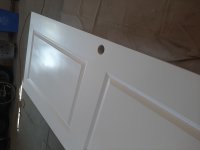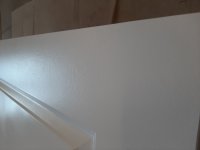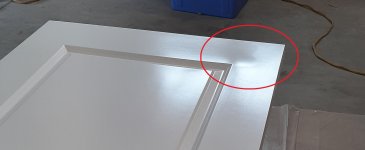Steve1
Member
I have a Fuji 5 stage turbine unit and the small G-XPC gun. Normally I use it for spraying water based poly, but this week I decided to learn how to spray acrylic paint.
I am painting doors, laid down flat. It can't get an easier than this.
Not going very well so far.
I am using Benjamin Moore Regal Select semi-gloss (35.5% solids)
First two attempts were definite failures and I will spare you the details.
Third attempt, I am getting closer. 1.8mm nozzle. I thinned to 27 seconds on Ford cup. Some Floetrol, but mostly water.
I narrowed the fan to get better atomization, but then I had to open up the fan size somewhat because spraying white on white I had a hard time seeing where I had already sprayed. Distance about 6". Not bad, but I could see a higher gloss level where (I expect) the paint went on thicker. Having difficulty spraying a "wet" surface.
View attachment 1
Fourth attempt (different door) I thinned to 33 seconds. Some Floetrol but mostly water. 1.8mm nozzle. I kept the fluid flow low to get good atomization, so I was moving the gun painfully slow and taking multiple passes. On a practise sheet, when I opened up the flow more, I started seeing spatter on the outside of the fan. I got closer with the gun, about 4-5" Still, I was not seeing a wet surface, so increased the fluid flow. I could see the air from the gun making ripples on the paint on the surface. But at least it was a wet surface. Not really orange peel, but not a smooth surface either. (photo is only 2 hours later)
View attachment 2
First the basics -
What should my target viscosity be ?
How far should my gun tip be from the workpiece ?
Any advise on how to achieve a good wet surface without opening up the flow too much ? (that was attempt #2, had to sand)
I am painting doors, laid down flat. It can't get an easier than this.
Not going very well so far.
I am using Benjamin Moore Regal Select semi-gloss (35.5% solids)
First two attempts were definite failures and I will spare you the details.
Third attempt, I am getting closer. 1.8mm nozzle. I thinned to 27 seconds on Ford cup. Some Floetrol, but mostly water.
I narrowed the fan to get better atomization, but then I had to open up the fan size somewhat because spraying white on white I had a hard time seeing where I had already sprayed. Distance about 6". Not bad, but I could see a higher gloss level where (I expect) the paint went on thicker. Having difficulty spraying a "wet" surface.
View attachment 1
Fourth attempt (different door) I thinned to 33 seconds. Some Floetrol but mostly water. 1.8mm nozzle. I kept the fluid flow low to get good atomization, so I was moving the gun painfully slow and taking multiple passes. On a practise sheet, when I opened up the flow more, I started seeing spatter on the outside of the fan. I got closer with the gun, about 4-5" Still, I was not seeing a wet surface, so increased the fluid flow. I could see the air from the gun making ripples on the paint on the surface. But at least it was a wet surface. Not really orange peel, but not a smooth surface either. (photo is only 2 hours later)
View attachment 2
First the basics -
What should my target viscosity be ?
How far should my gun tip be from the workpiece ?
Any advise on how to achieve a good wet surface without opening up the flow too much ? (that was attempt #2, had to sand)




